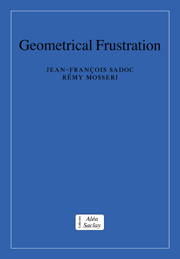Book contents
- Frontmatter
- Contents
- Preface
- 1 Introduction to geometrical frustration
- 2 Ideal models
- 3 Finite structures
- 4 Decurving and disclinations
- 5 Hierarchical polytopes
- 6 Some physical properties
- 7 Periodic structures with large cells
- 8 Quasiperiodic order and frustration
- A1 Spaces with constant curvature
- A2 Quaternions and related groups
- A3 Hopf fibration
- A4 Polytopes and honeycombs
- A5 Polytope {3, 3, 5}
- A6 Frank and Kasper coordination polyhedra
- A7 Quasiperiodic tilings: cut and projection
- A8 Differential geometry and parallel transport
- A9 Icosahedral quasicrystals and the E8 lattice
- Bibliography
- Index
7 - Periodic structures with large cells
Published online by Cambridge University Press: 06 January 2010
- Frontmatter
- Contents
- Preface
- 1 Introduction to geometrical frustration
- 2 Ideal models
- 3 Finite structures
- 4 Decurving and disclinations
- 5 Hierarchical polytopes
- 6 Some physical properties
- 7 Periodic structures with large cells
- 8 Quasiperiodic order and frustration
- A1 Spaces with constant curvature
- A2 Quaternions and related groups
- A3 Hopf fibration
- A4 Polytopes and honeycombs
- A5 Polytope {3, 3, 5}
- A6 Frank and Kasper coordination polyhedra
- A7 Quasiperiodic tilings: cut and projection
- A8 Differential geometry and parallel transport
- A9 Icosahedral quasicrystals and the E8 lattice
- Bibliography
- Index
Summary
Frustration and large cell crystals
We have described the occurrence of structural complexity in non-periodic systems as the result of geometrical frustration. This applies naturally to non-periodic structures like amorphous structures or quasicrystals, but also to some crystalline structures. In particular, it is interesting and instructive to analyse those periodic structures which also contain ingredients of frustration as a result, for instance, of local icosahedral configurations. We shall mainly focus on metals, or on clathrate structures which are dual from a geometrical point of view. Note that similar considerations could prove useful in systems with non-metallic interactions, for instance the C60 molecular crystal or the boron structure.
A major result of the above curved space approach is to propose a description of structural complexity at a range which is larger than that defined by the frustrated local interactions. Once the ideal structure has been defined in curved space, the appropriate range is related to the radius of curvature of the latter, which governs the average distance between the disclination decurving defects. The complexity is then encoded in the defect network itself. If ever this network adopts a periodic structure, this will often give rise to a large cell crystal. Since the paradigmatic example of frustration is to be found in close-packed metallic systems, it is then natural to look for their possible occurrence in nature. We shall also look at tetracoordinated (§7.4) and liquid crystalline (§7.5) periodic structures, in which similar networks can be recognized.
- Type
- Chapter
- Information
- Geometrical Frustration , pp. 158 - 195Publisher: Cambridge University PressPrint publication year: 1999



